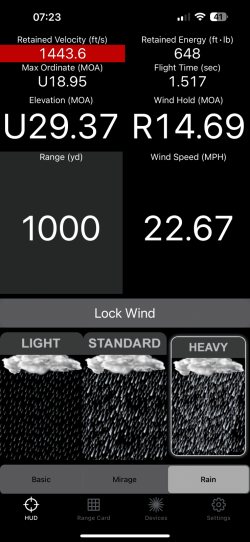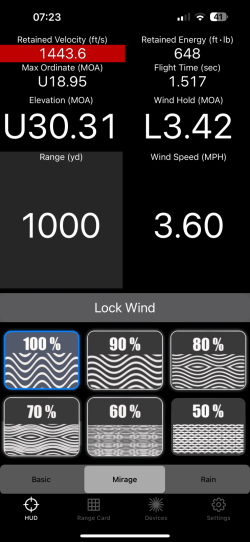No, not at all. The wind at the shooting position only affects the bullet while it is at the shooting position.I stand by my belief that the wind at the shooting position is more important than the last 1/3 of the bullet flight . It becomes a matter of time because the conditions has less time to effect the trajectory of the bullet where as the wind at shooting position has the whole length of the bullet flight to act upon it. Once the wind acts on the bullet it will continue moving in that direction, the further the distance the more it will move in the direction it was first acted upon. The conditions along the way will also effect the bullet flight but to a lesser extent. The wind along the bullet path would have much stronger than it was at the shooters position. Just my two cents,
If you are having success doing what you do my all means keep doing it.
You are using an out of date browser. It may not display this or other websites correctly.
You should upgrade or use an alternative browser.
You should upgrade or use an alternative browser.
How do you judge wind
- Thread starter wjm1000
- Start date
 Help Support Long Range Hunting Forum
Help Support Long Range Hunting Forum
dfanonymous
Well-Known Member
- Joined
- Jul 16, 2016
- Messages
- 2,257
It affects the bullet at its earliest point, and in which the bullet angle never goes back to its original course really. It's also the most accurate reading you have, since it's where you can measure it to the mph with the likes of a kestrel. It's a baseline reading.No, not at all. The wind at the shooting position only affects the bullet while it is at the shooting position.
Looking at mirage and foliage blowing 1200y away is an estimation in a certain percentile of accuracy depending on conditions and skill.
It mostly certainly is important in the first 1/3 if the shot.
That last 1/3 the bullet is moving the slowest. Depending how close to transonic one is at that last 3rd, a differentiating wind can certainly have an offset on the shot to a degree.
As said, we in PRS don't get spotters. Yet, you're scored and graded and qualified against others to 1/2 moa of accuracy at beyond 1000y…in wind..
Swag
3 good ways to read wind
Mirage
Rain
Wind meter
In my class, my method has been known to be world renowned for the most accurate
Come see me at Barbour Creek
Mirage
Rain
Wind meter
In my class, my method has been known to be world renowned for the most accurate
Come see me at Barbour Creek
trapper1954
Well-Known Member
I was taught to pay attention to the mirage. Dont shoot till it stops flowing when it lifts fire away. I've seen the bench rest guys and the spinners set every 50 yards and everyone of spinners telling a different story on the speed and directions in a 200 yard event.
Buffalobwana
Well-Known Member
I hunt more than shoot, so, I guess and squeeze. If it's too windy for my guess, I won't shoot.
If I'm shooting steel. I guess and squeeze and learn. That's how I know how to guess while hunting.
If I'm shooting steel. I guess and squeeze and learn. That's how I know how to guess while hunting.
First 1/3, second third or final third is all important, once the wind blows the bullet off course it doesn't go back. The most accurate reading of the wind is where you take the reading, doesn't matter if it is the first, second, or final third of the shooting lane. Jeff showed in a picture the flag at the line was hanging limp but noted down the line the winds were moving pretty good showing the winds throughout the line are equally important.It affects the bullet at its earliest point, and in which the bullet angle never goes back to its original course really. It's also the most accurate reading you have, since it's where you can measure it to the mph with the likes of a kestrel. It's a baseline reading.
Looking at mirage and foliage blowing 1200y away is an estimation in a certain percentile of accuracy depending on conditions and skill.
It mostly certainly is important in the first 1/3 if the shot.
That last 1/3 the bullet is moving the slowest. Depending how close to transonic one is at that last 3rd, a differentiating wind can certainly have an offset on the shot to a degree.
As said, we in PRS don't get spotters. Yet, you're scored and graded and qualified against others to 1/2 moa of accuracy at beyond 1000y…in wind..
As a hunter I don't typically get spotters either. We are scored by the meat in our freezers
I do it for a living
Max ord is most important unless shooting across a valley then I calculate that in.
Flat range you can get away with wind at you some times.
I shoot 5 days a week all year round
From 400 to 1600 yards.
Unless winds over 10 I use mirage extremely accurate if you know how.
Rain can be used in 40 mph wind extremely accurate again if you know how.
Wind meter is my last tool I use unless high wind and no rain and no mirage.
My new app in testing helps
Max ord is most important unless shooting across a valley then I calculate that in.
Flat range you can get away with wind at you some times.
I shoot 5 days a week all year round
From 400 to 1600 yards.
Unless winds over 10 I use mirage extremely accurate if you know how.
Rain can be used in 40 mph wind extremely accurate again if you know how.
Wind meter is my last tool I use unless high wind and no rain and no mirage.
My new app in testing helps
Attachments
Last edited:
Exactly!How much mirage will be visable on an overcast day when its 15 degrees?
comfisherman
Well-Known Member
I'll stand by my earlier comments, go outside and spend time observing even if all you use is windy app satellite images for speed where you are.
We're living in a day and age where life is so busy we reach out for a course or app or article is all we have time for. Reality is the best way to learn is to be where you want to hunt and watch the wind effects, then find a way to shoot in as similar situation as possible.
Few years back a friend who is in the industry took me with him as a plus 1 to a shooting school down in south west "merica. Was a ball, as it was sponsored by his work and a very generous event. The ambient temp during the day was probably warmer than the hottest day I've ever seen in my state. The wind reading scenario had almost no use for my hunt in Feb, near the 70th, with no direct sun and ambient Temps near -20f. Fun practice learning heat mirage, but won't have help my wolf hunt much. Only solution to that is time afield, lots of cold cold time afield.
We're living in a day and age where life is so busy we reach out for a course or app or article is all we have time for. Reality is the best way to learn is to be where you want to hunt and watch the wind effects, then find a way to shoot in as similar situation as possible.
Few years back a friend who is in the industry took me with him as a plus 1 to a shooting school down in south west "merica. Was a ball, as it was sponsored by his work and a very generous event. The ambient temp during the day was probably warmer than the hottest day I've ever seen in my state. The wind reading scenario had almost no use for my hunt in Feb, near the 70th, with no direct sun and ambient Temps near -20f. Fun practice learning heat mirage, but won't have help my wolf hunt much. Only solution to that is time afield, lots of cold cold time afield.
Plenty as long as sun shine. With overcast, you can still read Mirage with a good spotting scope we do this with overcast aswellExactly!
Mirage is not useful after 9 mph so you other methods at that point
Last edited:
The question skipglo responded to asked on it being overcast day when it's 15°. I agree when the sun's out there is a little bit more to use but overcast mirage is next to impossiblePlenty as long as sun shine. With overcast, you can still read Mirage with a good spotting scope we do this with overcast aswell
I agree experience is everything seems like a lot of people today want to rely upon electronics. And if their batteries fail they don't have the correct tools to use to do the job that they're trying to do. So to get outside and learn it is unbeatableI'll stand by my earlier comments, go outside and spend time observing even if all you use is windy app satellite images for speed where you are.
We're living in a day and age where life is so busy we reach out for a course or app or article is all we have time for. Reality is the best way to learn is to be where you want to hunt and watch the wind effects, then find a way to shoot in as similar situation as possible.
Few years back a friend who is in the industry took me with him as a plus 1 to a shooting school down in south west "merica. Was a ball, as it was sponsored by his work and a very generous event. The ambient temp during the day was probably warmer than the hottest day I've ever seen in my state. The wind reading scenario had almost no use for my hunt in Feb, near the 70th, with no direct sun and ambient Temps near -20f. Fun practice learning heat mirage, but won't have help my wolf hunt much. Only solution to that is time afield, lots of cold cold time afield.
Similar threads
- Replies
- 53
- Views
- 8K

